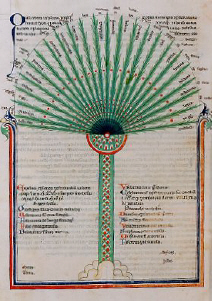Tradução da versão inglesa de MacKenna (abaixo)
1. Que arte há, que método, que disciplina para nos aportar aí onde devemos ir?
O Termo que devemos alcançar podemos aceitar como acordado: estabelecemos alhures, por muitas considerações, que nossa viagem é para o Bem, para o Princípio-Primal; e, de fato, o próprio raciocínio que descobriu o Termo foi ele mesmo algo como uma iniciação.
Mas que ordem de seres alcançarão o Termo?
Certamente, conforme lemos, aqueles que já viram tudo a maioria das coisas, aqueles que em seu primeiro nascimento entraram no embrião de vida do qual deve surgir um metafísico, um músico ou um amante de nascença, o metafísico tomando o caminho por instinto, o músico e a natureza peculiarmente suscetível a amar necessitando condução exterior.
Mas como se dispõe o curso? É o mesmo para todos, ou há um método distinto para cada classe de temperamento?
Para todos há dois estágios no caminho, conforme estão se elevando ou já ganharam a esfera superior.
O primeiro grau é a conversão desde a vida inferior; o segundo — mantido por aqueles que já fizeram seu caminho para a esfera dos Inteligíveis, estabeleceram como tal uma marca aí mas devem ainda avançar dentro do reino — pelo menos até alcançarem a conquista absoluta do lugar, o Termo alcançado quando o pico mais alto do reino Intelectual é conquistado.
Mas este grau mais alto deve aguardar seu tempo: vamos primeiro tentar falar do processo inicial de conversão.
Devemos começar pela distinção de três tipos. Tomemos o músico primeiro e indiquemos seu equipamento temperamental para a tarefa.
O músico podemos pensar como sendo excessivamente responsivo à beleza, arrebatado em um rapto por ela: de alguma forma lento em estimular seu próprio impulso, responde de pronto a estímulos externos: como os tímidos são sensitivos ao ruído assim ele aos tons e a beleza que apresentam; tudo que ofende contra uníssono ou harmonia em melodias e ritmos o repele; ele anseia por medida e padrões conformados.
Esta tendência natural deve ser o ponto de partida de tal homem; ele deve ser arrebatado pelo tom, ritmo e configuração em coisas dos sentidos: ele deve aprender a distinguir as formas materiais do Existente-Autêntico que é a forma de todas estas correspondências e da totalidade do esquema arrazoado na obra de arte: ele deve ser levado à Beleza que manifesta a si mesma através dessas formas; ele deve ser informado que o que o arrebata nada mais é que a Harmonia do mundo Intelectual e a Beleza naquela esfera, não uma forma qualquer de beleza mas a Beleza-Total, a Beleza Absoluta; e as verdades da filosofia devem ser implantadas nele para conduzi-lo à fé naquilo que, desconhecendo-o, ele possui dentro dele mesmo. O que estas verdades são demonstraremos mais tarde.
Versão inglesa de MacKenna
1. What art is there, what method, what discipline to bring us there where we must go?
The Term at which we must arrive we may take as agreed: we have established elsewhere, by many considerations, that our journey is to the Good, to the Primal-Principle; and, indeed, the very reasoning which discovered the Term was itself something like an initiation.
But what order of beings will attain the Term?
Surely, as we read, those that have already seen all or most things, those who at their first birth have entered into the life-germ from which is to spring a metaphysician, a musician or a born lover, the metaphysician taking to the path by instinct, the musician and the nature peculiarly susceptible to love needing outside guidance.
But how lies the course? Is it alike for all, or is there a distinct method for each class of temperament?
For all there are two stages of the path, as they are making upwards or have already gained the upper sphere.
The first degree is the conversion from the lower life; the second – held by those that have already made their way to the sphere of the Intelligibles, have set as it were a footprint there but must still advance within the realm – lasts until they reach the extreme hold of the place, the Term attained when the topmost peak of the Intellectual realm is won.
But this highest degree must bide its time: let us first try to speak of the initial process of conversion.
We must begin by distinguishing the three types. Let us take the musician first and indicate his temperamental equipment for the task.
The musician we may think of as being exceedingly quick to beauty, drawn in a very rapture to it: somewhat slow to stir of his own impulse, he answers at once to the outer stimulus: as the timid are sensitive to noise so he to tones and the beauty they convey; all that offends against unison or harmony in melodies and rhythms repels him; he longs for measure and shapely pattern.
This natural tendency must be made the starting-point to such a man; he must be drawn by the tone, rhythm and design in things of sense: he must learn to distinguish the material forms from the Authentic-Existent which is the source of all these correspondences and of the entire reasoned scheme in the work of art: he must be led to the Beauty that manifests itself through these forms; he must be shown that what ravished him was no other than the Harmony of the Intellectual world and the Beauty in that sphere, not some one shape of beauty but the All-Beauty, the Absolute Beauty; and the truths of philosophy must be implanted in him to lead him to faith in that which, unknowing it, he possesses within himself. What these truths are we will show later.
